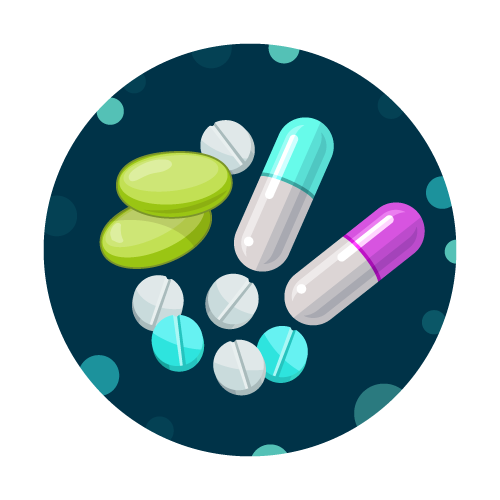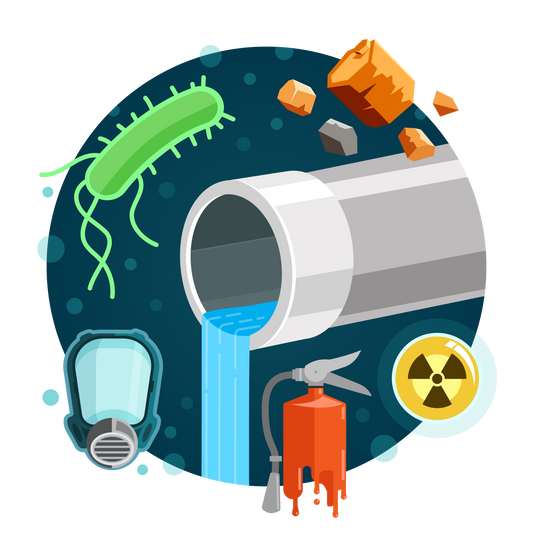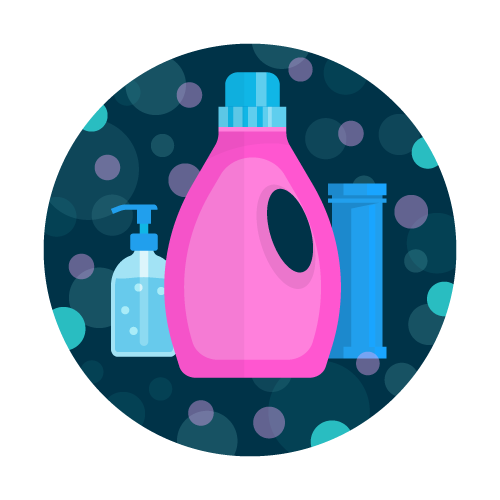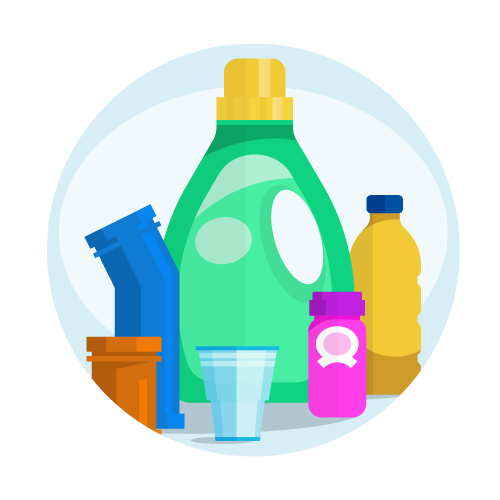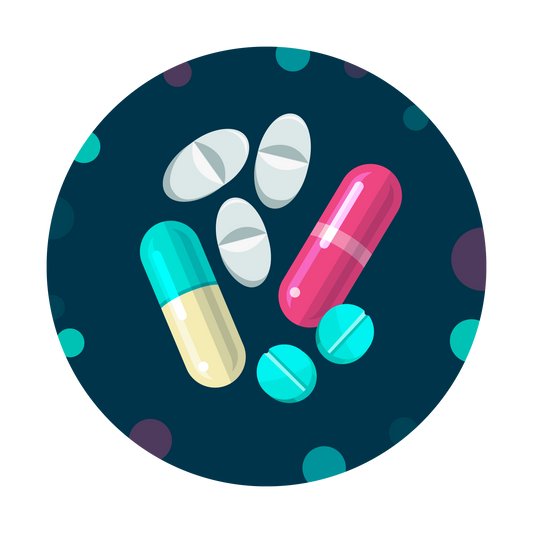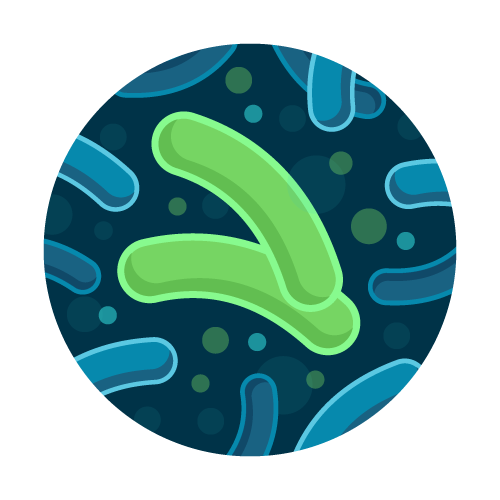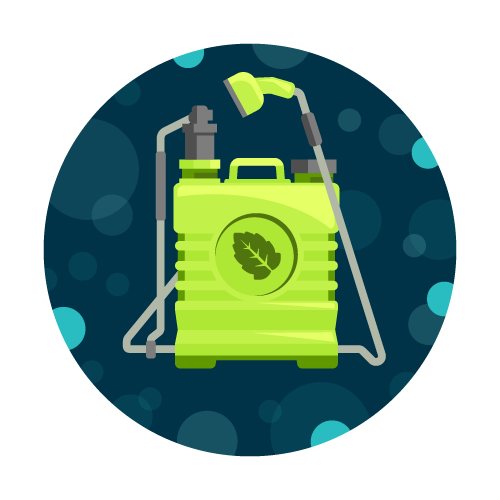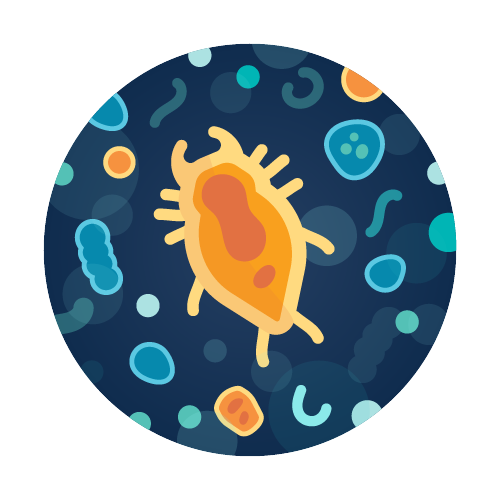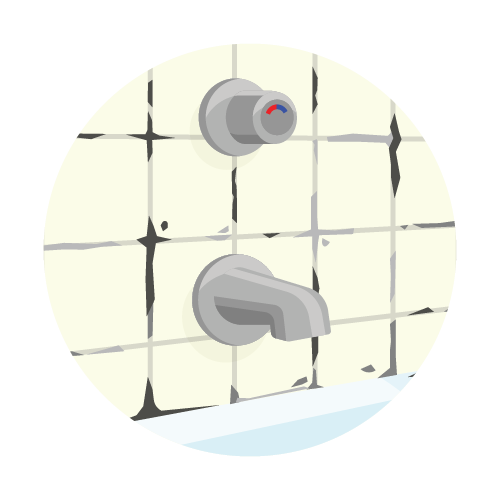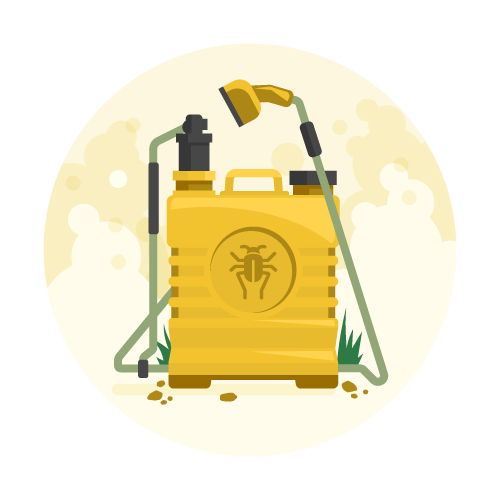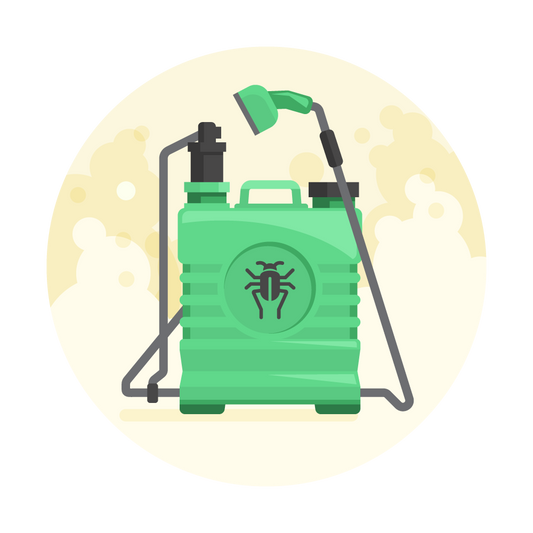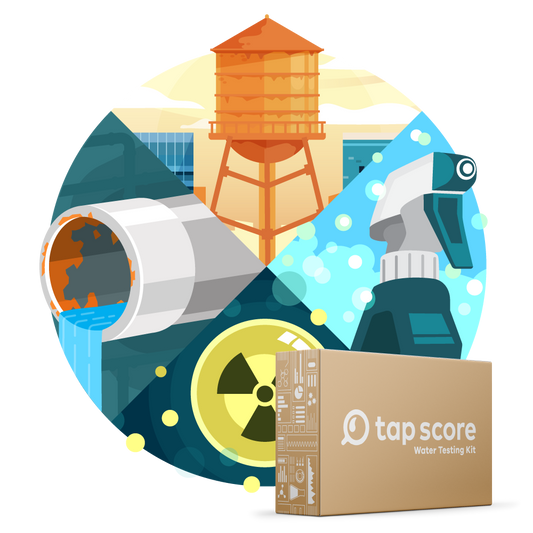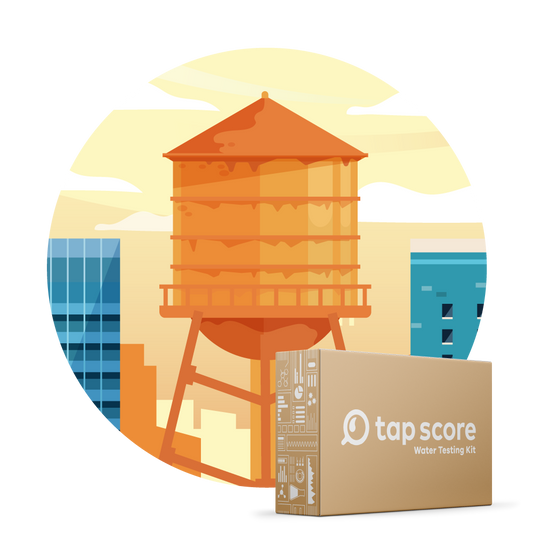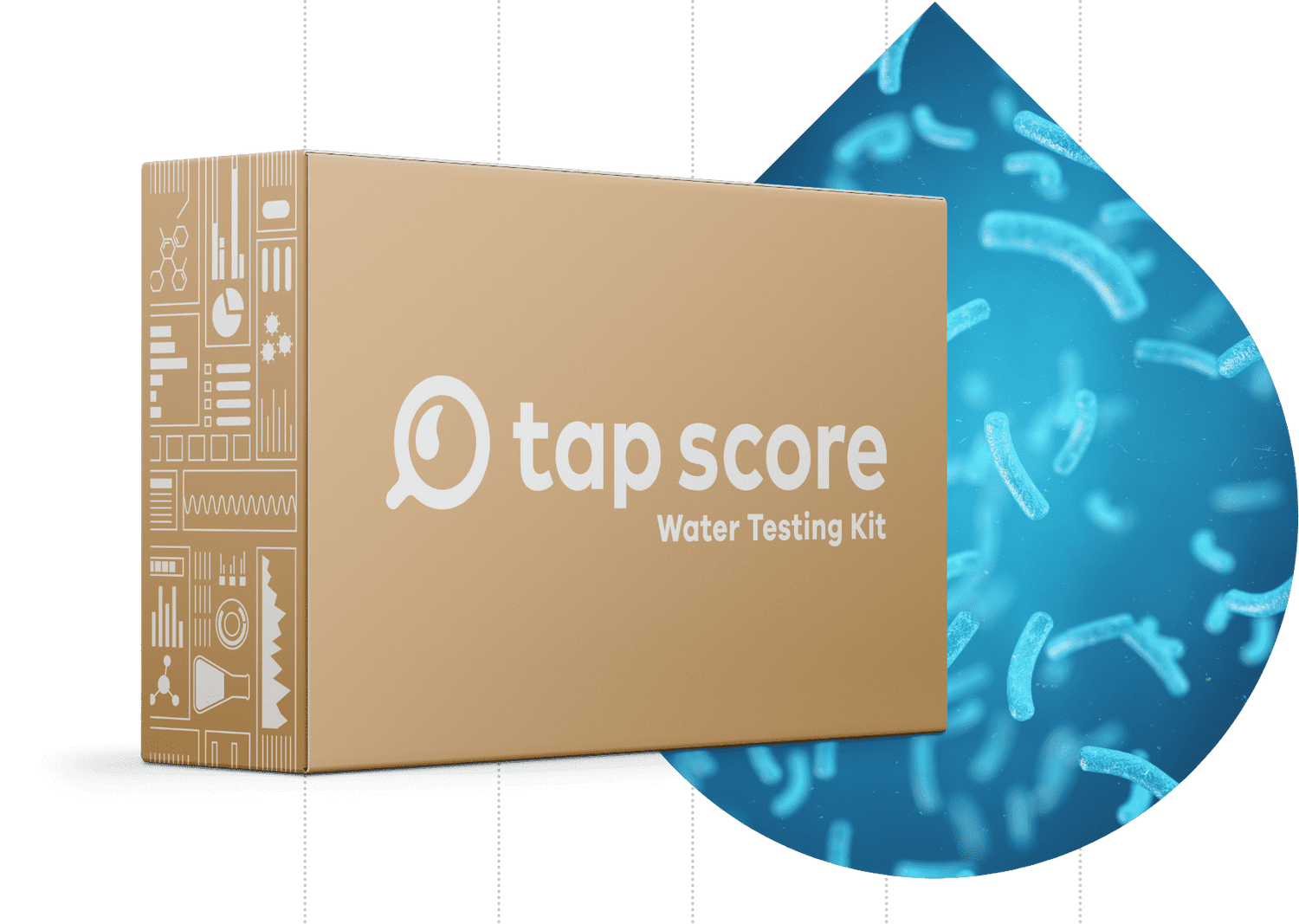
Contaminant
Glossary
Know exactly what you're looking for? Search below to learn more about specific contaminants and get product recommendations.
17 alpha estradiol
What is it?
17 alpha estradiol is a hormone produced naturally by humans and animals. Compared to another form of estradiol, 17 beta estradiol—which is a major hormone related to reproductive health—17 alpha estradiol does not have a well defined role in the body. Research into its functions and effects on the body is still ongoing, though there is evidence that it plays a protective role for nerve cells. Currently, a synthetic version of 17 alpha estradiol, known as Alfatradiol, is used to treat a condition that causes hair loss called androgenetic alopecia, and many other potential medical applications of 17 alpha estradiol are being researched.
Where does it come from?
17 alpha estradiol may enter the environment and drinking water sources through wastewater and discharge of unused medication to drains or landfills. Runoff from animal waste is another source of 17 alpha estradiol (and other types of estrogen) in the environment.
How does it affect me?
There is very little information available regarding health effects of 17 alpha estradiol in drinking water.
-
Specialized
Drugs and PPCP Water Test: 1
34 Analytes TestedTest for 34 common drugs, pharmaceuticals, steroids, hormones and endocrine disruptors in drinking water.
Regular price $885.00Regular priceUnit price / per$998.00Sale price $885.00
17 alpha ethynyl estradiol
What is it?
17 alpha ethinyl estradiol is an organic synthetic chemical. It is a synthetic version of the hormone estrogen and it is used in many contraceptive medications. Current water treatment technologies do not completely remove 17 alpha ethinyl estradiol from wastewater, and as a result it has been detected in surface water and treated drinking water.
Where does it come from?
17 alpha ethinyl estradiol is not naturally occurring, so its detection in the environment and source water is the result of human activity. It may enter drinking water sources through wastewater and discharge of unused medication to drains or landfills.
How does it affect me?
Health protective benchmarks for 17 alpha ethinyl estradiol in drinking water are based on potential developmental and reproductive health effects.
-
Specialized
Drugs and PPCP Water Test: 1
34 Analytes TestedTest for 34 common drugs, pharmaceuticals, steroids, hormones and endocrine disruptors in drinking water.
Regular price $885.00Regular priceUnit price / per$998.00Sale price $885.00
Acenaphthene
What is it?
Acenaphthene is a member of a class of organic chemicals called polycyclic aromatic hydrocarbons (PAHs) that occur naturally in coal tar and crude oil. It is produced commercially as an intermediate in producing soaps, plastics, and pharmaceuticals, and as an insecticide, herbicide, and fungicide.
Where does it come from?
Acenaphthene is widespread in the environment due to the use of coal and oil. The primary source of PAHs in drinking water is release from pipe coatings made of coal tar. They also enter source water naturally through rainwater runoff or dust particles settling in surface water. Additional sources include wastewater and landfill runoff. Elevated levels of PAHs like acenaphthene are most often present near hazardous waste sites.
How does it affect me?
Health protective benchmarks for acenaphthene in drinking water are based on potential adrenal and liver system effects.
-
Specialized
Most Comprehensive Water Test
359 Analytes TestedTest your drinking water with the most comprehensive single test package offered by Tap Score–from PFAS to pesticides to radiation to metals.
Regular price $2,575.00Regular priceUnit price / per -
Specialized
SVOC Water Test
66 Analytes TestedTest for a broad array of chemicals used in plastics, pesticides, flame-retardants, and more.
Regular price $315.00Regular priceUnit price / per$355.00Sale price $315.00 -
Specialized
Plastics Leachates Water Test
126 Analytes TestedTest your drinking water for a wide range of plastic-related contamination, including volatile and semi-volatile organic compounds.
Regular price $445.00Regular priceUnit price / per -
Specialized
Most Comprehensive Water Test
359 Analytes TestedTest your drinking water with the most comprehensive single test package offered by Tap Score–from PFAS to pesticides to radiation to metals.
Regular price $2,575.00Regular priceUnit price / per -
Specialized
SVOC Water Test
66 Analytes TestedTest for a broad array of chemicals used in plastics, pesticides, flame-retardants, and more.
Regular price $315.00Regular priceUnit price / per$355.00Sale price $315.00 -
Specialized
Plastics Leachates Water Test
126 Analytes TestedTest your drinking water for a wide range of plastic-related contamination, including volatile and semi-volatile organic compounds.
Regular price $445.00Regular priceUnit price / per -
Specialized
Most Comprehensive Water Test
359 Analytes TestedTest your drinking water with the most comprehensive single test package offered by Tap Score–from PFAS to pesticides to radiation to metals.
Regular price $2,575.00Regular priceUnit price / per
Acenaphthylene
What is it?
Acenaphthylene is a member of a class of organic chemicals called polycyclic aromatic hydrocarbons (PAHs) that occur naturally in coal tar and crude oil. Acenaphthylene has limited use in producing dyes, plastics, and pesticides.
Where does it come from?
Acenaphthylene is widespread in the environment due to the use of coal and oil. The primary source of PAHs in drinking water is release from pipe coatings made of coal tar. They also enter source water naturally through rainwater runoff or dust particles settling in surface water. Additional sources include wastewater and landfill runoff. Elevated levels of PAHs like acenaphthylene are most often present near hazardous waste sites.
How does it affect me?
Certain PAHs have been associated with an increased risk of cancer.
-
Specialized
Most Comprehensive Water Test
359 Analytes TestedTest your drinking water with the most comprehensive single test package offered by Tap Score–from PFAS to pesticides to radiation to metals.
Regular price $2,575.00Regular priceUnit price / per -
Specialized
SVOC Water Test
66 Analytes TestedTest for a broad array of chemicals used in plastics, pesticides, flame-retardants, and more.
Regular price $315.00Regular priceUnit price / per$355.00Sale price $315.00 -
Specialized
Plastics Leachates Water Test
126 Analytes TestedTest your drinking water for a wide range of plastic-related contamination, including volatile and semi-volatile organic compounds.
Regular price $445.00Regular priceUnit price / per -
Specialized
Most Comprehensive Water Test
359 Analytes TestedTest your drinking water with the most comprehensive single test package offered by Tap Score–from PFAS to pesticides to radiation to metals.
Regular price $2,575.00Regular priceUnit price / per -
Specialized
SVOC Water Test
66 Analytes TestedTest for a broad array of chemicals used in plastics, pesticides, flame-retardants, and more.
Regular price $315.00Regular priceUnit price / per$355.00Sale price $315.00 -
Specialized
Plastics Leachates Water Test
126 Analytes TestedTest your drinking water for a wide range of plastic-related contamination, including volatile and semi-volatile organic compounds.
Regular price $445.00Regular priceUnit price / per -
Specialized
Most Comprehensive Water Test
359 Analytes TestedTest your drinking water with the most comprehensive single test package offered by Tap Score–from PFAS to pesticides to radiation to metals.
Regular price $2,575.00Regular priceUnit price / per
Acesulfame-K
What is it?
Acesulfame-K, also known as Ace-K or acesulfame potassium, is an artificial sweetener. It is known commercially as Sunett® or Sweet One®. Acesulfame-K is manufactured to be 200 times sweeter than sugar, and is marketed as a low calorie alternative to sugar in foods and beverages like ice cream, yogurt, soda, and fruit juice. The body does not efficiently process acesulfame-K, so much of it is excreted; it can therefore be used as an indicator for the presence of wastewater in surface water and groundwater. Acesulfame-K has been detected in wastewater, surface water, groundwater, and drinking water.
Where does it come from?
Acesulfame-K is not naturally occuring, so its detection in the environment and source water is the result of human activity. It may enter drinking water sources through sewage discharge and wastewater treatment plant effluent and through waste streams and runoff from places where it is manufactured and stored.
How does it affect me?
Very little is known about the health effects of low concentrations of acesulfame-K in drinking water.
-
Specialized
Drugs and PPCP Water Test: 1
34 Analytes TestedTest for 34 common drugs, pharmaceuticals, steroids, hormones and endocrine disruptors in drinking water.
Regular price $885.00Regular priceUnit price / per$998.00Sale price $885.00
Acetaldehyde
What is it?
Acetaldehyde is a naturally occurring organic compound present in foods like coffee, bread, and fruit. It also forms in the human body as ethanol, the alcohol found in beverages like beer and wine, is metabolized. Additionally, acetaldehyde is commonly produced synthetically for industrial purposes, primarily as a precursor in the synthesis of other chemicals. It is also used in the production of perfumes, resins, dyes, and as a food preservative. Acetaldehyde has been detected in wastewater, surface water, groundwater, and drinking water.
Where does it come from?
Acetaldehyde can enter the environment and drinking water through various sources, including the respiration of large plants such as trees, the burning of wood, coal, and tobacco, coffee roasting, and emissions from vehicle exhaust.
How does it affect me?
Health protective benchmarks for acetaldehyde are based on its potential negative impacts on the respiratory and nervous systems and its potential to cause cancer. The EPA classifies acetaldehyde as a probable human carcinogen.
-
Aldehydes Water Test
10 Analytes TestedTest your drinking water for an array of aldehyeds–such as formaldehyde, which can form in the water supply following disinfection processes.
Regular price $335.00Regular priceUnit price / per
Acetaminophen
What is it?
Acetaminophen is a pain reliever and fever reducing agent found in various non-prescription medications, commonly sold under the brand name Tylenol. It is a contaminant of emerging concern that has been found in trace amounts in drinking water. It has been has also been detected in wastewater and surface water.
Where does it come from?
Acetaminophen is not naturally occurring, so its detection in the environment and source water is the result of human activity. It may enter drinking water sources through wastewater and discharge of unused medication to drains or landfills.
How does it affect me?
Health protective benchmarks for acetaminophen in drinking water are based on potential toxicity to the liver system.
-
Specialized
Drugs and PPCP Water Test: 2
49 Analytes TestedTest for 49 common drugs, pharmaceuticals, steroids, hormones and endocrine disruptors in drinking water.
Regular price $898.00Regular priceUnit price / per$1,005.00Sale price $898.00
Acidovorax delafieldii
What is it?
Acidovorax delafieldii is a species of Gram-negative, aerobic, motile bacteria that is naturally present in the environment. The species in the Acidovorax genus were originally classified as Pseudomonas species but were reassigned; some species are plant pathogens and/or opportunistic human pathogens, but there is very little information regarding the pathogenicity of Acidovorax delafieldii specifically. Certain bacteria may collect and proliferate in biofilms throughout drinking water distribution systems, though there is limited evidence regarding Acidovorax delafieldii in biofilms.
Where does it come from?
Acidovorax delafieldii occurs naturally in the environment and has been isolated from soil, water and clinical samples.
How does it affect me?
While certain species in the Acidovorax genus are opportunistic pathogens, very little information is available regarding the health effects and pathogenicity of Acidovorax delafieldii.
-
Specialized
5-Genus ID Water Test
32 Analytes TestedTest your drinking water to identify the 5 most prevalent bacterial genera present.
Regular price $369.00Regular priceUnit price / per$371.00Sale price $369.00
Acidovorax species
What is it?
Acidovorax is a genus of aerobic, Gram-negative bacteria that are naturally present in the environment and have been isolated from soil, water, infected plants, activated sludge and clinical samples. Acidovorax species were initially classified as Pseudomonas species but were reassigned. Some species are plant pathogens and others are opportunisitic human pathogens; they are rare causes of disease and typically impact individuals in a hospital setting. Certain bacteria may collect and proliferate in biofilms throughout drinking water distribution systems, though there is limited evidence regarding Acidovorax in biofilms.
Where does it come from?
Acidovorax species occur naturally in the environment and have been isolated from soil, water, infected plants, activated sludge and clinical samples.
How does it affect me?
Some species in the Acidovorax genus are opportunistic pathogens; they are rare causes of disease and typically impact individuals in hospital settings.
-
Specialized
5-Genus ID Water Test
32 Analytes TestedTest your drinking water to identify the 5 most prevalent bacterial genera present.
Regular price $369.00Regular priceUnit price / per$371.00Sale price $369.00
Acifluorfen
What is it?
Sodium acifluorfen (tradename Blazer) is a synthetic herbicide used in both agricultural and residential applications.
Where does it come from?
Sources of acifluorfen in the environment and drinking water include release during its production, as well as runoff or seepage where it is used as an herbicide.
How does it affect me?
There may be health effects associated with sodium acifluorfen, but evidence is limited.
-
Specialized
Herbicides Water Test
14 Analytes TestedTest your drinking water for common herbicides used in agricultural areas–including 2,4-D and dalapon.
Regular price $299.00Regular priceUnit price / per
Acinetobacter
What is it?
Acinetobacter is a genus of gram negative, rod-shaped bacteria that occurs naturally in soil and water. One species of concern that may be present in drinking water is Acinetobacter baumannii. Acinetobacter can survive on dry and moist surfaces, including the skin, and many strains have adapted to be resistant to commercially available antibiotics.
Where does it come from?
Acinetobacter are present in the environment in soil and water, including drinking water sources.
How does it affect me?
Most Acinetobacter infections occur in hospital settings due to the species Acinetobacter baumannii. Infections commonly impact the blood, urinary tract, lungs, and sites of wounds. Acinetobacter infections are rare outside of hospital settings, but immunocompromised individuals and those with chronic lung disease or diabetes may be more susceptible. Infections are treated with antibiotics, though many Acinetobacter species are antibiotic resistant.
-
Specialized
Total Microbiology Water Test
95 Analytes TestedTest for and identify an extensive array of microbial concerns–including bacteria, protozoa, HPC, and algae–with this comprehensive pathogen screen.
Regular price $395.00Regular priceUnit price / per
Acinetobacter junii
What is it?
Acinetobacter junii is a species of Gram-negative, aerobic, non-motile, coccobacillus found naturally in soil, water, and the human microflora. It is an opportunistic pathogen capable of causing infection, especially in hospital settings. A. junii strains have shown to be resistant to multiple different types of antibiotics. It may collect and proliferate in biofilms throughout drinking water distribution systems. It may also form biofilms on other surfaces, such as medical equipment. Acinetobacter species, such as A. junii, have been detected in wastewater, surface water, groundwater, and treated drinking water.
Where does it come from?
Acinetobacter junii occurs naturally in the environment in soil and water, as well as in the human microbiome, particularly on the skin and in the throat.
How does it affect me?
Most healthy people are resistant to Acinetobacter junii infections, so health effects primarily occur in high-risk, immunocompromised individuals. Acinetobacter junii is an opportunistic pathogen that may cause infections of the skin, bloodstream, and respiratory tract. These infections commonly occur in hospital settings.
-
Specialized
5-Genus ID Water Test
32 Analytes TestedTest your drinking water to identify the 5 most prevalent bacterial genera present.
Regular price $369.00Regular priceUnit price / per$371.00Sale price $369.00
Acremonium
What is it?
Acremonium is a genus of filamentous fungi belonging to the family Hypocreaceae. Acremonium species occur naturally in the environment in areas with lots of moisture and places containing decaying organic matter, as well as in indoor environments with excessive moisture from things like water damage. Acremonium colonies grow slowly and turn from moist to powdery as they age. Colonies may appear white, gray, or pinkish in color. Acremonium species have been detected in groundwater, surface water, and treated drinking water. Certain fungi may collect and proliferate in biofilms throughout drinking water distribution systems, though there is limited evidence regarding Acremonium species in biofilms.
Where does it come from?
Acremonium species occur naturally in the environment in soil and water. They thrive in moist environments and places with decaying vegetation. Acremonium species are sometimes also detected in food.
How does it affect me?
Most healthy people are resistant to Acremonium species infections, so health effects primarily occur in high-risk, immunocompromised individuals. Certain Acremonium species are opportunistic pathogens that may cause infections such as mycetoma in immunocompromised individuals.
-
Specialized
Total Microbiology Water Test
95 Analytes TestedTest for and identify an extensive array of microbial concerns–including bacteria, protozoa, HPC, and algae–with this comprehensive pathogen screen.
Regular price $395.00Regular priceUnit price / per
Acremonium
What is it?
Acremonium is a genus of filamentous fungi belonging to the family Hypocreaceae. Acremonium species occur naturally in the environment in areas with lots of moisture and places containing decaying organic matter, as well as in indoor environments with excessive moisture from things like water damage. Acremonium colonies grow slowly and turn from moist to powdery as they age. Colonies may appear white, gray, or pinkish in color. Acremonium species have been detected in groundwater, surface water, and treated drinking water. Certain fungi may collect and proliferate in biofilms throughout drinking water distribution systems, though there is limited evidence regarding Acremonium species in biofilms.
Where does it come from?
Acremonium species occur naturally in the environment in soil and water. They thrive in moist environments and places with decaying vegetation. Acremonium species are sometimes also detected in food.
How does it affect me?
Most healthy people are resistant to Acremonium species infections, so health effects primarily occur in high-risk, immunocompromised individuals. Certain Acremonium species are opportunistic pathogens that may cause infections such as mycetoma in immunocompromised individuals.
-
Specialized
Mold and Fungus Water Test
32 Analytes TestedTest for mold and fungal contamination in drinking water, as well as total heterotrophic bacteria.
Regular price $225.00Regular priceUnit price / per
Acrolein
What is it?
Acrolein is a volatile organic compound primarily used to produce other chemicals, including acrylic acid. It is also used in livestock feed, chemical weapons production, and as a biocide for controlling underwater algae and plant growth in industrial facilities. It is readily volatile, thus all routes of exposure (ingestion, inhalation and dermal) are relevant if one is exposed via drinking water. Elevated levels of acrolein in drinking water are associated with respiratory toxicity and genotoxicity. Acrolein breaks down readily in the environment, and it is not likely to be found in water sources.
Where does it come from?
Acrolein enters the environment and drinking water sources through release from chemical plants and hazardous waste sites.
How does it affect me?
Health protective benchmarks for acrolein have been developed based on respiratory toxicity observed in animal studies. Acrolein has been shown to produce DNA changes (genotoxicity) in laboratory studies.
-
Specialized
Acrolein Water Test
1 Analyte TestedTest your drinking water for this pungent herbicide used to control weeds and algae in irrigation canals.
Regular price $199.00Regular priceUnit price / per
Acrylamide
What is it?
Acrylamide is a volatile organic compound (VOC) that forms through natural reactions in plant-based foods including potatoes and cereal-grain. It is primarily used to produce the widely-used polyacrylamide and acrylamide copolymers. These chemicals are used in a multitude of industrial processes, including paper, dye, and plastic production and water treatment; they are also present in certain consumer products, for example food packaging and adhesives. It is readily volatile, thus all routes of exposure (ingestion, inhalation and dermal) are relevant if one is exposed via drinking water.
Where does it come from?
Acrylamide may enter the environment and drinking water through industrial release during its production and use. The primary source of acrylamide in drinking water is the use of polyacrylamides in drinking water treatment.
How does it affect me?
Drinking water standards for acrylamide are based on potential nervous and blood system toxicity, and an increased risk of cancer. Additional health protective benchmarks are based on potential developmental and male reproductive system toxicity. The EPA classifies it as a likely human carcinogen.
-
Specialized
Acrylamide Water Test
1 Analyte TestedTest your drinking water for acrylamide, which is used in fabrication of polymers and in wastewater treatment.
Regular price $269.00Regular priceUnit price / per
Actinoptychus senarius
What is it?
Actinoptychus senarius is a species of disc-shaped diatoms found in freshwater, brackish, and marine environments. It may float freely in bodies of water or attach to plants, rocks, and animals. A. senarius typically exists as single cells or in loosely associated groups.
Where does it come from?
Actinoptychus senarius occurs naturally in freshwater, brackish, and marine environments, typically near the coast.
How does it affect me?
Very little information is available regarding the health effects of Actinoptychus senarius in drinking water, but it is not thought to be harmful.
-
Specialized
Total Microbiology Water Test
95 Analytes TestedTest for and identify an extensive array of microbial concerns–including bacteria, protozoa, HPC, and algae–with this comprehensive pathogen screen.
Regular price $395.00Regular priceUnit price / per
Alachlor
What is it?
Alachlor is an organic compound and herbicide. It is used to control weeds on croplands (including corn, soybeans, and peanuts) and non-agricultural areas. Its use has declined in recent years due to the increased use of competing herbicides, especially acetochlor and glyphosate.
Where does it come from?
Alachlor primarily enters the environment and drinking water sources through runoff and seepage from sites where it is used as an herbicide. Release from sites where it is produced is an additional source.
How does it affect me?
Drinking water standards for alachlor are based on potential toxicity to the eyes, liver, spleen, kidney, and blood system as well as an increased risk of cancer.
-
Specialized
Pesticides Water Test
9 Analytes TestedTest your drinking water for important pesticides, insecticides, and herbicides popular in agricultural areas.
Regular price $225.00Regular priceUnit price / per$259.00Sale price $225.00
Alcaligenes Faecalis
What is it?
Alcaligenes faecalis is a species of aerobic, Gram-negative, rod-shaped bacteria that occurs naturally in the environment and is commonly found in hospitals. It is resistant to many antibiotics.
Where does it come from?
Alcaligenes faecalis occurs naturally in soil and water, including drinking water sources.
How does it affect me?
Most healthy people are resistant to Alcaligenes faecalis infections, so health effects primarily occur in high-risk, immunocompromised individuals. Alcaligenes faecalis is an opportunistic pathogen that may cause bloodstream, urinary tract, and soft tissue infections in immunocompromised individuals.
-
Specialized
Total Microbiology Water Test
95 Analytes TestedTest for and identify an extensive array of microbial concerns–including bacteria, protozoa, HPC, and algae–with this comprehensive pathogen screen.
Regular price $395.00Regular priceUnit price / per
Aldrin
What is it?
Aldrin is an organochlorine pesticide that was used widely on crops like corn and cotton and for termite abatement in the past, but all uses have been canceled since the 1980s. It is structurally similar to the pesticide dieldrin, and transforms into dieldrin in the environment and the human body, so they are typically discussed together. Aldrin is readily volatile, thus all routes of exposure (ingestion, inhalation and dermal) are relevant if one is exposed via drinking water.
Where does it come from?
Aldrin is not naturally occurring, so its detection in the environment and source water is the result of human activity. Sources of aldrin in the environment and drinking water include runoff and seepage from hazardous waste sites, and its continued presence in the environment from past uses as a pesticide on crops and for termite abatement. Aldrin binds strongly to soil and is therefore not likely to enter groundwater.
How does it affect me?
The EPA has classified aldrin as a probable human carcinogen with little or no evidence of carcinogenicity in humans, and sufficient evidence in animals. In addition, health protective benchmarks for aldrin have been developed based on an increased risk of cancer and liver toxicity.
-
Specialized
PCBs and Chlorinated Pesticides Water Test
27 Analytes TestedTest your drinking water for polychlorinated biphenyls (PCBs), chlorinated pesticides, and insecticides–such as DDT and Lindane.
Regular price $364.00Regular priceUnit price / per
Alkalinity (as CaCO3)
What is it?
Alkalinity is a key measure of a water sample's general chemistry. Alkalinity measures the capacity of water to neutralize acids. Alkalinity is thus indicative of the stability of a water sample's pH upon the addition of acid; water with higher alkalinity will maintain a stable pH after the addition of more acid. Water with low alkalinity cannot buffer against such changes and can therefore become acidic and potentially corrosive to plumbing.The vast majority of alkalinity comes from dissolved carbonate and bicarbonate, though other compounds, like phosphates and borates, contribute minorly to alkalinity.
Where does it come from?
Alkalinity is a property of water determined by the minerals that dissolve into water as it passes through soil and rocks, primarily carbonate-containing minerals. Runoff from agricultural and industrial areas can also affect alkalinity.
How does it affect me?
There are no known direct human health impacts related to the alkalinity of drinking water. However, alkalinity that is either very high or low can be corrosive to plumbing, which may lead to the release of heavy metals like lead.
-
Specialized
Most Comprehensive Water Test
359 Analytes TestedTest your drinking water with the most comprehensive single test package offered by Tap Score–from PFAS to pesticides to radiation to metals.
Regular price $2,575.00Regular priceUnit price / per -
Specialized
Basic Brewers Water Test
9 Analytes TestedTest water used for brewing to analyze important paramets that impact taste, enzyme activity, and equipment condition.
Regular price $134.00Regular priceUnit price / per -
Ultimate Home Water Test
256 Analytes TestedExpanded testing package for tap water from a local water utility or a private well–especially those concerned about farming or agricultural contamination.
Regular price $369.00Regular priceUnit price / per -
Specialized
Most Comprehensive Water Test
359 Analytes TestedTest your drinking water with the most comprehensive single test package offered by Tap Score–from PFAS to pesticides to radiation to metals.
Regular price $2,575.00Regular priceUnit price / per -
Specialized
Basic Brewers Water Test
9 Analytes TestedTest water used for brewing to analyze important paramets that impact taste, enzyme activity, and equipment condition.
Regular price $134.00Regular priceUnit price / per -
Ultimate Home Water Test
256 Analytes TestedExpanded testing package for tap water from a local water utility or a private well–especially those concerned about farming or agricultural contamination.
Regular price $369.00Regular priceUnit price / per -
Specialized
Most Comprehensive Water Test
359 Analytes TestedTest your drinking water with the most comprehensive single test package offered by Tap Score–from PFAS to pesticides to radiation to metals.
Regular price $2,575.00Regular priceUnit price / per
Alpha BHC
Where does it come from?
An organic fertilizer.
-
Specialized
PCBs and Chlorinated Pesticides Water Test
27 Analytes TestedTest your drinking water for polychlorinated biphenyls (PCBs), chlorinated pesticides, and insecticides–such as DDT and Lindane.
Regular price $364.00Regular priceUnit price / per
Alternaria
What is it?
Alternaria is a genus of fungi that causes brown spots on leaves and can lead to leaf death. Fungi may collect and proliferate in biofilms throughout drinking water distribution systems; certain Alternaria spp. have been isolated from biofilms in drinking water distribution systems.
Where does it come from?
Alternaria is widespread in the environment and source water due to the spreading of its spores in wind and water.
-
Specialized
Mold and Fungus Water Test
32 Analytes TestedTest for mold and fungal contamination in drinking water, as well as total heterotrophic bacteria.
Regular price $225.00Regular priceUnit price / per
Aluminum
What is it?
Aluminum is a naturally-occurring metal found in the Earth's crust with multiple industrial uses, including the construction of buildings and powerlines, and the manufacture of vehicles, consumer electronics, household appliances, and kitchenware. It is also frequently used in municipal water treatment to clarify water from lakes and reservoirs. Health effects of aluminum exposure are inconclusive but actively researched.
Where does it come from?
Aluminum may enter water sources through leaching from soil or rock, or from industrial activities like metal refining and mining operations. Elevated aluminum levels in drinking water can also result from municipal treatment processes that use aluminum-based coagulants.
How does it affect me?
Much of the current research on the health effects of aluminum in drinking water is still inconclusive and controversial. Health protective benchmarks for aluminum in drinking water set by the California Office of Environmental Health Hazard Assessment are based on potential neurotoxicity and developmental toxicity in premature infants. People more susceptible to aluminum impacts include infants and people with impaired kidney function.
-
Specialized
Most Comprehensive Water Test
359 Analytes TestedTest your drinking water with the most comprehensive single test package offered by Tap Score–from PFAS to pesticides to radiation to metals.
Regular price $2,575.00Regular priceUnit price / per -
Specialized
Metals and Minerals Water Test
35 Analytes TestedTest your drinking water for a broad array of common metals and minerals–including those related to plumbing issues, scaling, and hardness.
Regular price $119.00Regular priceUnit price / per -
Ultimate Home Water Test
256 Analytes TestedExpanded testing package for tap water from a local water utility or a private well–especially those concerned about farming or agricultural contamination.
Regular price $369.00Regular priceUnit price / per -
Specialized
Most Comprehensive Water Test
359 Analytes TestedTest your drinking water with the most comprehensive single test package offered by Tap Score–from PFAS to pesticides to radiation to metals.
Regular price $2,575.00Regular priceUnit price / per -
Specialized
Metals and Minerals Water Test
35 Analytes TestedTest your drinking water for a broad array of common metals and minerals–including those related to plumbing issues, scaling, and hardness.
Regular price $119.00Regular priceUnit price / per -
Ultimate Home Water Test
256 Analytes TestedExpanded testing package for tap water from a local water utility or a private well–especially those concerned about farming or agricultural contamination.
Regular price $369.00Regular priceUnit price / per -
Specialized
Most Comprehensive Water Test
359 Analytes TestedTest your drinking water with the most comprehensive single test package offered by Tap Score–from PFAS to pesticides to radiation to metals.
Regular price $2,575.00Regular priceUnit price / per
Ametryn
What is it?
Ametryn is a member of a class of organic herbicides called triazines. It is used to contain weeds in the agricultural industry (especially for corn, sugarcane, and pineapple crops). Ametryn has been detected in surface and groundwater.
Where does it come from?
Sources of ametryn in the environment and drinking water include industrial release and agricultural runoff.
How does it affect me?
Health protective benchmarks for ametryn have been developed based on potential liver toxicity.
-
Specialized
Most Comprehensive Water Test
359 Analytes TestedTest your drinking water with the most comprehensive single test package offered by Tap Score–from PFAS to pesticides to radiation to metals.
Regular price $2,575.00Regular priceUnit price / per -
Specialized
EPA 538 Fungicide and Pesticide Water Test
140 Analytes TestedTest your drinking water for an array of pesticides, fungicides, insecticides, herbicides and other organics.
Regular price $265.00Regular priceUnit price / per$309.00Sale price $265.00 -
Ultimate Home Water Test
256 Analytes TestedExpanded testing package for tap water from a local water utility or a private well–especially those concerned about farming or agricultural contamination.
Regular price $369.00Regular priceUnit price / per -
Specialized
Most Comprehensive Water Test
359 Analytes TestedTest your drinking water with the most comprehensive single test package offered by Tap Score–from PFAS to pesticides to radiation to metals.
Regular price $2,575.00Regular priceUnit price / per -
Specialized
EPA 538 Fungicide and Pesticide Water Test
140 Analytes TestedTest your drinking water for an array of pesticides, fungicides, insecticides, herbicides and other organics.
Regular price $265.00Regular priceUnit price / per$309.00Sale price $265.00 -
Ultimate Home Water Test
256 Analytes TestedExpanded testing package for tap water from a local water utility or a private well–especially those concerned about farming or agricultural contamination.
Regular price $369.00Regular priceUnit price / per -
Specialized
Most Comprehensive Water Test
359 Analytes TestedTest your drinking water with the most comprehensive single test package offered by Tap Score–from PFAS to pesticides to radiation to metals.
Regular price $2,575.00Regular priceUnit price / per
Ammonia
What is it?
Ammonia is a naturally occuring gas made up of nitrogen and hydrogen that dissolves in water to form the ammonium ion, which has an additional hydrogen and a positive charge. It is also manufactured and primarily used in fertilizers, but is also used in the manufacturing of synthetic fibers, plastics and explosives. Ammonia provides nitrogen to plants and can be naturally converted to nitrite and nitrate by bacteria. At high levels, ammonia can be toxic to aquatic life.
Where does it come from?
Ammonia occurs naturally in both groundwater and surface waters and results from the natural breakdown of nitrogen-containing organic matter. It is also often added to municipal tap water along with chlorine to form chloramines for disinfection. In addition, ammonia can enter source waters due to contamination by sewage, industrial effluent and agricultural runoff.
How does it affect me?
Human health impacts are not expected due to exposure to ammonia at concentrations relevant to drinking water.
-
Specialized
Ammonia Water Test
1 Analyte TestedTest your drinking water for ammonia–a popular chloramine precursor used in water treatment plants.
Regular price $89.00Regular priceUnit price / per
Anthracene
What is it?
Anthracene is an organic chemical and a member of a class of chemicals called polycyclic aromatic hydrocarbons (PAHs) that occur naturally in coal tar, petroleum, and crude oil. Anthracene is used to make pesticides, dyes, and plastics.
Where does it come from?
Anthracene is widespread in the environment due to the use of coal and oil. The primary source of PAHs in drinking water is release from pipe coatings made of coal tar. They also enter source water naturally through rainwater runoff or dust particles settling in surface water. Additional sources include wastewater and landfill runoff. Elevated levels of PAHs like anthracene are most often present near hazardous waste sites.
How does it affect me?
Health protective benchmarks for anthracene are based on adverse health effects that are not specific to a single organ or system (i.e., reduced body weight).
-
Specialized
Most Comprehensive Water Test
359 Analytes TestedTest your drinking water with the most comprehensive single test package offered by Tap Score–from PFAS to pesticides to radiation to metals.
Regular price $2,575.00Regular priceUnit price / per -
Specialized
SVOC Water Test
66 Analytes TestedTest for a broad array of chemicals used in plastics, pesticides, flame-retardants, and more.
Regular price $315.00Regular priceUnit price / per$355.00Sale price $315.00 -
Specialized
Plastics Leachates Water Test
126 Analytes TestedTest your drinking water for a wide range of plastic-related contamination, including volatile and semi-volatile organic compounds.
Regular price $445.00Regular priceUnit price / per -
Specialized
Most Comprehensive Water Test
359 Analytes TestedTest your drinking water with the most comprehensive single test package offered by Tap Score–from PFAS to pesticides to radiation to metals.
Regular price $2,575.00Regular priceUnit price / per -
Specialized
SVOC Water Test
66 Analytes TestedTest for a broad array of chemicals used in plastics, pesticides, flame-retardants, and more.
Regular price $315.00Regular priceUnit price / per$355.00Sale price $315.00 -
Specialized
Plastics Leachates Water Test
126 Analytes TestedTest your drinking water for a wide range of plastic-related contamination, including volatile and semi-volatile organic compounds.
Regular price $445.00Regular priceUnit price / per -
Specialized
Most Comprehensive Water Test
359 Analytes TestedTest your drinking water with the most comprehensive single test package offered by Tap Score–from PFAS to pesticides to radiation to metals.
Regular price $2,575.00Regular priceUnit price / per
Antimony
What is it?
Antimony is a metal most commonly used as a flame retardant and occasionally as solder in plumbing. High levels of antimony in drinking water are rare. However, antimony levels can be elevated if drinking water sources are exposed to industrial discharges, contaminated by wastewater, or potentially leachate from antimony-containing solder. Health protective levels of antimony in drinking water are based on animal studies that show long term exposure may result in adverse health effects, including liver damage and reduced longevity.
Where does it come from?
The main sources of antimony in drinking water are discharge from petroleum refineries and leaching from metal plumbing and fittings. Antimony also enters the environment through natural weathering and a variety of human-made sources including mining wastes, manufacturing of flame retardants, ceramics, and electronics, runoff from fertilizers, leaching from landfills, and fossil fuel combustion.
How does it affect me?
Health protective levels of antimony in drinking water have been established based on liver toxicity and reduced longevity observed in animal studies. Additional animal studies have shown that lifetime exposure to high levels of antimony in drinking water can result in blood toxicity, changes in blood cholesterol levels, and decreased blood sugar.
-
Specialized
Most Comprehensive Water Test
359 Analytes TestedTest your drinking water with the most comprehensive single test package offered by Tap Score–from PFAS to pesticides to radiation to metals.
Regular price $2,575.00Regular priceUnit price / per -
Specialized
Metals and Minerals Water Test
35 Analytes TestedTest your drinking water for a broad array of common metals and minerals–including those related to plumbing issues, scaling, and hardness.
Regular price $119.00Regular priceUnit price / per -
Ultimate Home Water Test
256 Analytes TestedExpanded testing package for tap water from a local water utility or a private well–especially those concerned about farming or agricultural contamination.
Regular price $369.00Regular priceUnit price / per -
Specialized
Most Comprehensive Water Test
359 Analytes TestedTest your drinking water with the most comprehensive single test package offered by Tap Score–from PFAS to pesticides to radiation to metals.
Regular price $2,575.00Regular priceUnit price / per -
Specialized
Metals and Minerals Water Test
35 Analytes TestedTest your drinking water for a broad array of common metals and minerals–including those related to plumbing issues, scaling, and hardness.
Regular price $119.00Regular priceUnit price / per -
Ultimate Home Water Test
256 Analytes TestedExpanded testing package for tap water from a local water utility or a private well–especially those concerned about farming or agricultural contamination.
Regular price $369.00Regular priceUnit price / per -
Specialized
Most Comprehensive Water Test
359 Analytes TestedTest your drinking water with the most comprehensive single test package offered by Tap Score–from PFAS to pesticides to radiation to metals.
Regular price $2,575.00Regular priceUnit price / per
Arsenate
What is it?
Arsenate, or arsenic V, is a highly toxic inorganic form of the element arsenic; it is one of two forms of arsenic commonly found in drinking water (the other is arsenic III, or arsenite). Arsenate and arsenite can convert back and forth depending on the conditions in the water, and arsenate is typically present in higher concentrations than arsenite. By far, the most common use of arsenate is as a preservative for wood; for example, copper chromated arsenate (CCA) is used to produce "pressure-treated" lumber. CCA is no longer used in the US for residential applications, but is still used in industrial applications. Arsenic has been found in surface water, groundwater and drinking water throughout the US, though higher levels of arsenic tend to be found in groundwater sources than in surface water.
Where does it come from?
Arsenic is a common element in the earth's crust and is present in its different inorganic forms in minerals and soil. Inorganic arsenic can enter groundwater via the erosion of arsenic-containing mineral deposits. It can also enter water via runoff from commercial sources such as from sites producing wood preservatives, petroleum production, and metal mining and smelting.
How does it affect me?
Drinking water standards for inorganic arsenic are based on dermal and blood system toxicity as well as an increased risk of cancer. The EPA classifies inorganic arsenic as a known human carcinogen.
-
Specialized
Arsenic Speciation Water Test
3 Analytes TestedDetermine the oxidation state of arsenic in your drinking water–arsenic III or arsenic V.
Regular price $435.00Regular priceUnit price / per
Arsenic
What is it?
Arsenic is a naturally occurring element that has elemental, organic, and inorganic forms. The two forms of arsenic commonly found in drinking water that present a health risk are inorganic: arsenic III, or arsenite, and arsenic V, or arsenate. Inorganic forms of arsenic are considered highly toxic while most organic forms are considered to be essentially non-toxic. Certain organic arsenic compounds, including various methyl and phenyl derivatives, may pose a toxicity risk. Inorganic arsenic was previously used in the production of copper chromated arsenate, a wood preservative, while organic forms were primarily used as pesticides. Safer alternatives have now mostly replaced arsenic in these applications, but arsenic is persistent in the environment so past contamination sources remain relevant. Organic arsenic was also previously used as an additive in animal feed before the FDA withdrew approval for arsenic-based animal drugs. Elemental arsenic is primarily used in the production of arsenic alloys, which are often used in lead-acid batteries, as well as in semiconductors and light-emitting diodes. These are the primary applications of arsenic in the current day. Arsenic has been found in surface water, groundwater, and drinking water throughout the US, though higher levels of arsenic tend to be found in groundwater sources than in surface water.
Where does it come from?
Arsenic is a common element in the earth's crust and is present in its different inorganic forms in minerals and soil. Arsenic can enter groundwater via the erosion of arsenic-containing mineral deposits. It can also enter water via runoff from commercial and industrial sources such as mining and smelting, petroleum production, and semiconductor manufacture. It previously entered the environment and drinking water sources through contamination from sites producing wood preservatives, pesticide applications, and animal feed additives before these applications were discontinued.
How does it affect me?
The EPA drinking water limits for arsenic are based on adverse effects effects to the skin and circulatory systems, as well as an increased risk of cancer. Long-term exposures to low-levels of arsenic concentrations in drinking water are associated with an increased risk for several types of cancer including bladder, gastrointestinal tract, kidney, liver, lung, pancreas, and skin. In addition to skin and circulatory impacts, other non-cancerous health effects of long term exposure to arsenic found in epidemiological studies include developmental effects, cardiovascular effects, pulmonary disease, gastrointestical effects, ocular effects, impaired immune response, neurotoxicity, and diabetes. Human studies also show that arsenic is genotoxic. High doses of arsenic can be lethal, and lower (yet still elevated) levels of arsenic exposure can result in acute health effects. The first signs of arsenic exposure may include a metallic taste in the mouth or a garlicky odor on the breath. This is followed by health effects including abdominal pain, nausea, vomiting, diarrhea, muscle cramps, weakness, tingling, and numbness. These impacts are unlikely at concentrations found in drinking water.
-
Specialized
Most Comprehensive Water Test
359 Analytes TestedTest your drinking water with the most comprehensive single test package offered by Tap Score–from PFAS to pesticides to radiation to metals.
Regular price $2,575.00Regular priceUnit price / per -
Specialized
Total Arsenic Water Test
1 Analyte TestedTest your drinking water for total arsenic–a common groundwater contaminant that can be toxic.
Regular price $74.00Regular priceUnit price / per -
Specialized
Metals and Minerals Water Test
35 Analytes TestedTest your drinking water for a broad array of common metals and minerals–including those related to plumbing issues, scaling, and hardness.
Regular price $119.00Regular priceUnit price / per -
Ultimate Home Water Test
256 Analytes TestedExpanded testing package for tap water from a local water utility or a private well–especially those concerned about farming or agricultural contamination.
Regular price $369.00Regular priceUnit price / per -
Specialized
Arsenic Speciation Water Test
3 Analytes TestedDetermine the oxidation state of arsenic in your drinking water–arsenic III or arsenic V.
Regular price $435.00Regular priceUnit price / per -
Specialized
Most Comprehensive Water Test
359 Analytes TestedTest your drinking water with the most comprehensive single test package offered by Tap Score–from PFAS to pesticides to radiation to metals.
Regular price $2,575.00Regular priceUnit price / per -
Specialized
Total Arsenic Water Test
1 Analyte TestedTest your drinking water for total arsenic–a common groundwater contaminant that can be toxic.
Regular price $74.00Regular priceUnit price / per -
Specialized
Metals and Minerals Water Test
35 Analytes TestedTest your drinking water for a broad array of common metals and minerals–including those related to plumbing issues, scaling, and hardness.
Regular price $119.00Regular priceUnit price / per -
Ultimate Home Water Test
256 Analytes TestedExpanded testing package for tap water from a local water utility or a private well–especially those concerned about farming or agricultural contamination.
Regular price $369.00Regular priceUnit price / per -
Specialized
Arsenic Speciation Water Test
3 Analytes TestedDetermine the oxidation state of arsenic in your drinking water–arsenic III or arsenic V.
Regular price $435.00Regular priceUnit price / per -
Specialized
Most Comprehensive Water Test
359 Analytes TestedTest your drinking water with the most comprehensive single test package offered by Tap Score–from PFAS to pesticides to radiation to metals.
Regular price $2,575.00Regular priceUnit price / per
Arsenite
What is it?
Arsenite, or arsenic III, is a highly toxic inorganic form of the element arsenic; it is one of two forms of arsenic commonly found in drinking water (the other is arsenic V, or arsenate). Arsenate and arsenite can convert back and forth depending on the conditions in the water, and arsenate is typically present in higher concentrations than arsenite. Arsenite has a multitude of uses; it's most common use is in the production of the arsenate-containing compound copper chromated arsenate, which is used as a wood preservative. In the past, arsenite was used in the production of herbicides and pesticides but these applications are no longer allowed in the US. Arsenic has been found in surface water, groundwater and drinking water throughout the US, though higher levels of arsenic tend to be found in groundwater sources than in surface water.
Where does it come from?
Arsenic is a common element in the earth's crust and is present in its different inorganic forms in minerals and soil. Inorganic arsenic can enter groundwater via the erosion of arsenic-containing mineral deposits. It can also enter water via runoff from commercial sources such as from sites producing wood preservatives, petroleum production, and metal mining and smelting.
How does it affect me?
Drinking water standards for inorganic arsenic are based on dermal and blood system toxicity as well as an increased risk of cancer. The EPA classifies inorganic arsenic as a known human carcinogen.
-
Specialized
Arsenic Speciation Water Test
3 Analytes TestedDetermine the oxidation state of arsenic in your drinking water–arsenic III or arsenic V.
Regular price $435.00Regular priceUnit price / per
Aspergillus
What is it?
The Aspergillus fungi genus comprise over 300 species. Aspergillus species (spp.) exist in biofilms in the drinking water distribution system and home plumbing are the primary sources of exposure in drinking water.
Where does it come from?
Aspergillus spp. are ubiquitous in the environment, including in freshwater, water for bathing, and drinking water. Surface waters with high organic matter content are more conducive to Aspergillus spp. growth compared with groundwater.
How does it affect me?
Aspergillus species are considered opportunistic pathogens, but adverse health outcomes from exposure are rare and limited to people who are immunocompromised or in hospitals.
-
Specialized
Mold and Fungus Water Test
32 Analytes TestedTest for mold and fungal contamination in drinking water, as well as total heterotrophic bacteria.
Regular price $225.00Regular priceUnit price / per
Aspergillus flavus
What is it?
Aspergillus flavus is a member of a genus of molds called aspergillus. Aspergillus can volatilize as biomolecules, so inhalation (from showering/cooking) is a relevant exposure pathway, in addition to dermal contact with or ingestion of contaminated water.
Where does it come from?
Aspergillus are ubiquitous in the environment, including in freshwater, water for bathing, and drinking water. Surface waters with high organic matter content are more conducive to Aspergillus species (spp.) growth compared with groundwater. Aspergillus biofilms in the drinking water distribution system and home plumbing are the primary sources of exposure in drinking water.
How does it affect me?
Aspergillus species may cause opportunistic infections called aspergillosis that most commonly impact the lungs; however, adverse health outcomes are rare and typically only occur in immunocompromised individuals.
-
Specialized
Mold and Fungus Water Test
32 Analytes TestedTest for mold and fungal contamination in drinking water, as well as total heterotrophic bacteria.
Regular price $225.00Regular priceUnit price / per
Aspergillus fumigatus
What is it?
Aspergillus fumigatus is a member of a genus of molds called aspergillus. Aspergillus can volatilize as biomolecules, so inhalation (from showering/cooking) is a relevant exposure pathway, in addition to dermal contact with or ingestion of contaminated water.
Where does it come from?
Aspergillus are ubiquitous in the environment, including in freshwater, water for bathing, and drinking water. Surface waters with high organic matter content are more conducive to Aspergillus species (spp.) growth compared with groundwater. Aspergillus biofilms in the drinking water distribution system and home plumbing are the primary sources of exposure in drinking water.
How does it affect me?
Aspergillus species may cause opportunistic infections called aspergillosis that most commonly impact the lungs; however, adverse health outcomes are rare and typically only occur in immunocompromised individuals.
-
Specialized
Mold and Fungus Water Test
32 Analytes TestedTest for mold and fungal contamination in drinking water, as well as total heterotrophic bacteria.
Regular price $225.00Regular priceUnit price / per
Aspergillus nidulans
What is it?
Aspergillus nidulans is a member of a genus of molds called aspergillus. Aspergillus can volatilize as biomolecules, so inhalation (from showering/cooking) is a relevant exposure pathway, in addition to dermal contact with or ingestion of contaminated water.
Where does it come from?
Aspergillus are ubiquitous in the environment, including in freshwater, water for bathing, and drinking water. Surface waters with high organic matter content are more conducive to Aspergillus species (spp.) growth compared with groundwater. Aspergillus biofilms in the drinking water distribution system and home plumbing are the primary sources of exposure in drinking water.
How does it affect me?
Aspergillus species may cause opportunistic infections called aspergillosis that most commonly impact the lungs; however, adverse health outcomes are rare and typically only occur in immunocompromised individuals.
-
Specialized
Mold and Fungus Water Test
32 Analytes TestedTest for mold and fungal contamination in drinking water, as well as total heterotrophic bacteria.
Regular price $225.00Regular priceUnit price / per
Aspergillus niger
What is it?
Aspergillus niger is a species of mold found virtually everywhere in the environment. It is commonly detected in the air, soil, and water, and grows on decaying organic matter. It has been detected in groundwater, surface water, and tap water. A. niger grows in black or brown circular formations and forms biofilms in water distribution systems. It spreads quickly, as it releases spores early on in its life cycle. It is the cause of the disease "black mold" in certain fruits and vegetables. A. niger is also used in the biotechnology industry to produce certain food enzymes and organic acids since it can survive in acidic environments. Its resistance to antifungal treatments also makes it ideal for testing the efficacy of food preservatives.
Where does it come from?
Aspergillus niger is widespread in the environment and source waters due to the spreading of its spores in wind, soil, and water.
How does it affect me?
Most healthy people are resistant to Aspergillus niger infections, so health effects primarily occur in high-risk, immunocompromised individuals. Aspergillus niger an opportunistic human pathogen that may cause lung infections in immunocompromised individuals.
-
Specialized
Mold and Fungus Water Test
32 Analytes TestedTest for mold and fungal contamination in drinking water, as well as total heterotrophic bacteria.
Regular price $225.00Regular priceUnit price / per
Aspergillus ochraceus
What is it?
Aspergillus ochraceus is a member of a genus of molds called aspergillus. Aspergillus can volatilize as biomolecules, so inhalation (from showering/cooking) is a relevant exposure pathway, in addition to dermal contact with or ingestion of contaminated water.
Where does it come from?
Aspergillus are ubiquitous in the environment, including in freshwater, water for bathing, and drinking water. Surface waters with high organic matter content are more conducive to Aspergillus species (spp.) growth compared with groundwater. Aspergillus biofilms in the drinking water distribution system and home plumbing are the primary sources of exposure in drinking water.
How does it affect me?
Aspergillus species may cause opportunistic infections called aspergillosis that most commonly impact the lungs; however, adverse health outcomes are rare and typically only occur in immunocompromised individuals.
-
Specialized
Mold and Fungus Water Test
32 Analytes TestedTest for mold and fungal contamination in drinking water, as well as total heterotrophic bacteria.
Regular price $225.00Regular priceUnit price / per
Aspergillus versicolor
Where does it come from?
Aspergillus versicolor is a slow-growing filamentous fungus commonly found in damp indoor environments and on food products. Aspergillus are ubiquitous in the environment, including freshwater, water for bathing, and in drinking water.
How does it affect me?
Not much is known about the various health impacts of Aspergillus species in drinking water but at low concentrations they are unlikely to have major health impacts. At higher concentrations, Aspergillus species can cause allergic reaction, produce potentially harmful mycotoxins and other microbial volatile organic compounds.
-
Specialized
Mold and Fungus Water Test
32 Analytes TestedTest for mold and fungal contamination in drinking water, as well as total heterotrophic bacteria.
Regular price $225.00Regular priceUnit price / per
Asterionella
What is it?
Asterionella is a genus of diatom—a type of single celled algae—that forms star-shaped colonies in freshwater. Asterionella formosa is one of the most commonly encountered species within the Asterionella genus, and it is one of the abundant planktonic diatoms in nutrient rich lakes in the northern hemisphere. Excessive Asterionella growth in freshwaters caused by significantly elevated nutrient levels can harm aquatic ecosystems by decreasing oxygen levels in water and blocking sunlight from reaching underwater plants, which may lead to the death of aquatic plants and animals and decreased water quality.
Where does it come from?
Asterionella colonies commonly form in fresh surface water, including drinking water sources, with medium to high levels of nutrients.
How does it affect me?
There has been very little research into the health impacts of Asterionella species in drinking water, but they are not considered to be harmful to human health.
-
Specialized
Total Microbiology Water Test
95 Analytes TestedTest for and identify an extensive array of microbial concerns–including bacteria, protozoa, HPC, and algae–with this comprehensive pathogen screen.
Regular price $395.00Regular priceUnit price / per
Atrazine
What is it?
Atrazine is a synthetic organic compound and part of a class of herbicides called triazines, which inhibit photosynthesis. Atrazine is contained in hundreds of weed-killing products, and widely used on crops such as corn, sugarcane, pineapples, and sorghum. Atrazine is now a restricted-use pesticide in the United States, so only certified herbicide users may purchase or use it. Health effects associated with elevated levels of atrazine in drinking water include reproductive, developmental, and cardiovascular toxicity as well as an increased risk of cancer. It has been detected in both surface and groundwater sources.
Where does it come from?
Atrazine does not occur naturally in the environment, so its detection in certain surface and groundwater sources can be attributed to human release. It primarily enters drinking water from soil leaching or agricultural runoff in areas where it is used to control weed growth.
How does it affect me?
Drinking water standards for atrazine have been developed based on toxicity to reproductive and cardiovascular systems. Additional health protective benchmarks have been developed based on developmental toxicity and an increased risk of cancer observed in animal studies, but the EPA has not classified atrazine as a carcinogen. Elevated levels of atrazine have also been associated with cardiovascular toxicity based on animal studies.
-
Specialized
Pesticides Water Test
9 Analytes TestedTest your drinking water for important pesticides, insecticides, and herbicides popular in agricultural areas.
Regular price $225.00Regular priceUnit price / per$259.00Sale price $225.00
Aureobasidium
What is it?
Aureobasidium is a genus of 14 species of dematiaceous fungi. Fungi may collect and proliferate in biofilms throughout drinking water distribution systems; certain Aureobasidium have been isolated from biofilms in drinking water distribution systems.
Where does it come from?
Fungi like aureobasidium are ubiquitous in the environment and drinking water sources as a result of natural processes.
How does it affect me?
Adverse health outcomes are rare and typically only occur in immunosuppressed individuals.
-
Specialized
Mold and Fungus Water Test
32 Analytes TestedTest for mold and fungal contamination in drinking water, as well as total heterotrophic bacteria.
Regular price $225.00Regular priceUnit price / per
Azithromycin
What is it?
Azithromycin is a semisynthetic organic compound (it is synthesized from a naturally occuring compound) in a group called macrolide antibiotics that is known commercially as Zirthromax. Azithromycin treats a variety of different bacterial infections. It has been detected in surface water, groundwater, treated wastewater and finished drinking water. Studies have shown that trace amounts of antibiotics like azithromycin in water may contribute to antibiotic resistance in certain bacteria. Additionally, azithromycin has been shown to be toxic to aquatic ecosystems.
Where does it come from?
Azithromycin is not naturally occurring, so its detection in the environment and source water is the result of human activity. It may enter drinking water sources through wastewater and discharge of unused medication to drains or landfills.
How does it affect me?
Little is known about the human health effects of low concentrations of azithromycin in drinking water.
-
Specialized
Drugs and PPCP Water Test: 2
49 Analytes TestedTest for 49 common drugs, pharmaceuticals, steroids, hormones and endocrine disruptors in drinking water.
Regular price $898.00Regular priceUnit price / per$1,005.00Sale price $898.00
Azoxystrobin
What is it?
Azoxystrobin is a fungicide in the class of compounds called ß-methoxyacrylates, and it used to protect a broad range of crops from disease. Its products may exist as liquids to spray on crops or granules used to treat the soil. It is persistent in the environment, and may remain in soil for months as it is not readily mobile in soil, but azoxystrobin breaks down faster in water when exposed to sunlight. Though it is not very mobile in soil it is sometimes possible for it to seep through the soil into groundwater. Azoxystrobin is highly toxic to many marine organisms.
Where does it come from?
Azoxystrobin is not naturally occurring, so its detection in the environment and source water is the result of human activity. It may enter the environment and drinking water sources through runoff and seepage in areas where it is used as a fungicide. Chemical spills at sites where it is produced or stored are an additional source.
How does it affect me?
Elevated levels of azoxystrobin may impact human health, but evidence is limited.
-
Specialized
Most Comprehensive Water Test
359 Analytes TestedTest your drinking water with the most comprehensive single test package offered by Tap Score–from PFAS to pesticides to radiation to metals.
Regular price $2,575.00Regular priceUnit price / per -
Specialized
EPA 538 Fungicide and Pesticide Water Test
140 Analytes TestedTest your drinking water for an array of pesticides, fungicides, insecticides, herbicides and other organics.
Regular price $265.00Regular priceUnit price / per$309.00Sale price $265.00 -
Ultimate Home Water Test
256 Analytes TestedExpanded testing package for tap water from a local water utility or a private well–especially those concerned about farming or agricultural contamination.
Regular price $369.00Regular priceUnit price / per -
Specialized
Most Comprehensive Water Test
359 Analytes TestedTest your drinking water with the most comprehensive single test package offered by Tap Score–from PFAS to pesticides to radiation to metals.
Regular price $2,575.00Regular priceUnit price / per -
Specialized
EPA 538 Fungicide and Pesticide Water Test
140 Analytes TestedTest your drinking water for an array of pesticides, fungicides, insecticides, herbicides and other organics.
Regular price $265.00Regular priceUnit price / per$309.00Sale price $265.00 -
Ultimate Home Water Test
256 Analytes TestedExpanded testing package for tap water from a local water utility or a private well–especially those concerned about farming or agricultural contamination.
Regular price $369.00Regular priceUnit price / per -
Specialized
Most Comprehensive Water Test
359 Analytes TestedTest your drinking water with the most comprehensive single test package offered by Tap Score–from PFAS to pesticides to radiation to metals.
Regular price $2,575.00Regular priceUnit price / per
Explore Core Kits
Why test only a single substance?
Our Core Kits test for multiple contaminants with a single water sample and are custom designed for your specific drinking water source. If you only bought one test today, these would be it.
Extended City Water Test
Comprehensive testing for the core concerns impacting utility-provided tap water, plus analysis of radioactive particles and additional disinfection byproducts.
Essential City Water Test
Basic test panel for water utility customers primarily concerned by metals, aging pipes, and infrastructure.
Advanced City Water Test
Ideal baseline for testing tap water provided by a local water utility–including metals, minerals, and chlorine-related byproducts.
MOST POPULAR
Extended City Water Test
Comprehensive testing for the core concerns impacting utility-provided tap water, plus analysis of radioactive particles and additional disinfection byproducts.
Essential City Water Test
Basic test panel for water utility customers primarily concerned by metals, aging pipes, and infrastructure.
Advanced City Water Test
Ideal baseline for testing tap water provided by a local water utility–including metals, minerals, and chlorine-related byproducts.
MOST POPULAR
Extended City Water Test
Comprehensive testing for the core concerns impacting utility-provided tap water, plus analysis of radioactive particles and additional disinfection byproducts.
Have questions
about specific
contaminants?
We could talk about analytes all day. So if you want to get into the scientific weeds with us or have questions about any of our specialized tests, we're here to help.
How effective are single tests?
Our specialized tests are highly focused, provide deep analysis of fewer contaminants, and designed for people with very specific needs. If you would like to analyze your water more broadly (and sometimes more cost effectively), we recommend our Core Kit collection.
What if I don't know what I need?
If you have specific reasons for testing but can't find what you're looking for, try our Customize Your Kit feature. After answering a few simple questions, we will curate some options for you.
What if my water source is unique?
We've never met a water sample we couldn't analyze. So whether your drinking water comes from rural sources, urban sources or anything in between, we can test it. Try our City Water, Well Water, Rain Water or Spring Water Core Kits for starters.
Can I take more than one sample?
Each testing kit is designed for a single sample at a single location in your home or on your property (i.e. kitchen sink). If you want to test your water at multiple locations, you will need multiple testing packages.

